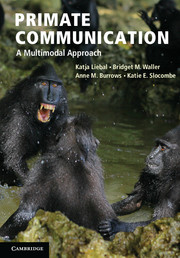Book contents
- Frontmatter
- Contents
- Preface
- Acknowledgements
- Part I Introduction to primate communication
- 1 What is primate communication?
- 2 The morphology of primate communication
- 3 The neural substrates of primate communication
- Part II Approaches to primate communication
- Part III Cognitive characteristics of primate communication
- Part IV Approaches to the evolution of primate communication
- Glossary
- References
- Species index
- Subject index
1 - What is primate communication?
Published online by Cambridge University Press: 05 December 2013
- Frontmatter
- Contents
- Preface
- Acknowledgements
- Part I Introduction to primate communication
- 1 What is primate communication?
- 2 The morphology of primate communication
- 3 The neural substrates of primate communication
- Part II Approaches to primate communication
- Part III Cognitive characteristics of primate communication
- Part IV Approaches to the evolution of primate communication
- Glossary
- References
- Species index
- Subject index
Summary
This chapter starts with a general introduction to the two main components of this book: primates and communication. After describing how the term communication is used in this book and how communication can be approached on different levels, primates are introduced with a focus on the variety of their social systems and potential factors that influence their formation. Finally, this diversity of primate social systems is discussed with special reference to the role of communication in maintaining such complex social systems. However, while the aim of this chapter is to provide an overview of primates and their communication in different social systems, Chapter 10 will focus in more detail on the evolution of primate communication with special reference to the role of social organization in the emergence of particular communicative systems.
What is communication?
Scientists are often particularly interested in the communication of primates, as opposed to other animals, in the hope that it will shed light on the evolution of human communication. The assumption underlying this comparative approach is that as monkeys and apes are phylogenetically closely related to humans, both human and nonhuman primates must share characteristics in the way they communicate. One specific hope, of course, is that an understanding of primate communication will lead to a better understanding of the evolution of human language.
- Type
- Chapter
- Information
- Primate CommunicationA Multimodal Approach, pp. 3 - 30Publisher: Cambridge University PressPrint publication year: 2013



